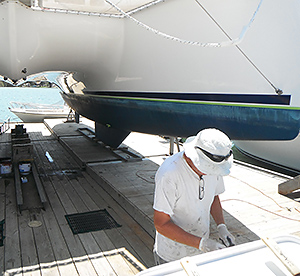Having decided what antifouling you are going to apply we need to consider the condition of your hull.
Irrespective of which paint is already on your hull, it should be in good condition with little or no damage and be compatible with the antifouling we are going to apply.

- We will need to give the surface a good wet sand. This will remove the top layer of paint that is depleted in biocides, contains salt and calcium deposits and is not in a condition to accept a new coat of paint. Failure to remove this layer will lead to blistering, de-lamination or even poor antifouling performance as ingredients and biocides in the new paint permeate the old depleted layer.
- If the paint is an unknown product, after sanding and washing, we allow it to dry thoroughly and apply a sealer/tie coat. This will seal the old antifouling avoiding unwanted interaction between old and new and will create a surface the new antifouling can bond to, otherwise the freshly applied antifouling will fall off.
- If the hull has damaged areas these will require re-priming.
- The hull waterline is masked, all underwater strainers, skin, grates and fittings below the water line are masked/prepared for Antifouling.
- Advanced Industry leading Antifoul is applied to the hull to the manufacturers specifications after final preparation post the priming stage.
- To surfaces made of aluminum, only an Antifoul having a copper-free, organo-tin base must be applied, therefore, it is pretty common, that more than one type of Antifoul is used on a Vessel (e.g. a fibreglass hull with a Stern Drive).
- All other inlets, hoses, speedo, etc are cleaned and de-masked.
- Anodes are placed back on the vessel or replaced if required.
After the manufacturers recommended cure time, the vessel is put back into the water, and is ready for delivery.
